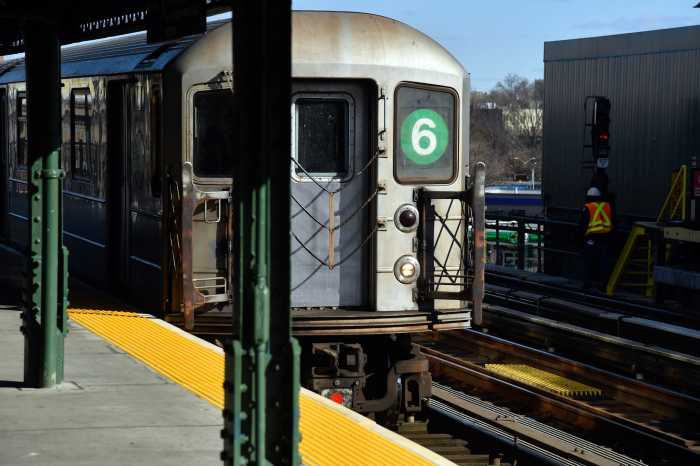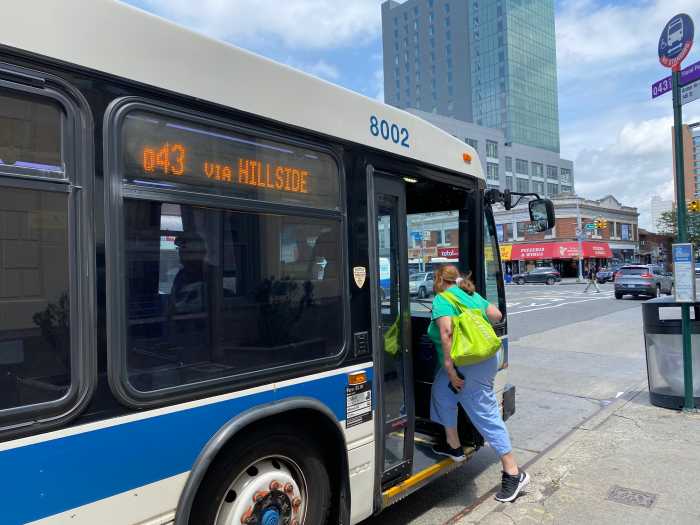
Subway riders and their advocates groaned last fall when the MTA launched a pilot to remove some seats from E trains and now, nearly seven months later, the authority can’t say if the project has impacted service.
Last October, the MTA undertook two projects on the E line simultaneously: one to remove seats on some 260 cars and the other to replace every car’s “master controller,” which is responsible for the braking and acceleration of trains.
The mechanical work “attack[ed] a significant cause of failures on these cars,” while the seat removals attempted to get more riders into cars “in a more efficient manner,” MTA chairman Joe Lhota said in a statement announcing the work.
While the controller replacements seem to have paid off in limiting car breakdowns, it’s unclear if the seat removals have had any benefit to service. Shams Tarek, an MTA spokesman, said that there were too many variables that impact service to truly make a determination. He stressed that the pilot was primarily to add capacity inside E trains.
“The refurbished car pilot has been a success with the mean distance between car failures on the E line improving substantially since October,” Tarek said in a statement. “Overall line performance is also dependent upon myriad other factors including signals, track, debris, and issues on other lines that spread to others, and that incredibly broad agenda is exactly what [New York City Transit] President [Andy] Byford is focused on tackling head-on with the fully funded Subway Action Plan and his upcoming corporate plan for NYC Transit.”
E trains are running longer without breaking down since the work took place, according to data provided by the MTA. Trains on the line broke down every 216,693 miles, according to a three-month average of data leading up to last October. Those trains now break down every 306,836 miles, a 41.6 percent increase, according to the three-month average leading into March 2018.
Train sets running with fewer seats could accommodate between 80 and 100 additional commuters, according to the MTA. Adding that extra space might not have made boarding any more efficient — though the impact is difficult to divine because just 100 of the 260 cars running on the E had some seats removed.
Based on the metric Capacity Provided, the percentage of scheduled trains that are actually provided during rush hours, E service actually got slightly worse after the seats were removed, dropping from 93.4 percent of scheduled trains provided in October 2017 to 92.8 percent in March 2018, the latest data available.
And statistics from the metric known as Additional Platform Time, which measures the additional time commuters spend waiting on platforms for their trains by comparing schedules and MetroCard swipes, remained flat at 1.2 minutes when comparing October 2017 data to March 2018.
“If the MTA can’t quantify how much performance has improved or not improved due to the removal of these seats, that’s a problem,” said Jaqi Cohen, campaign coordinator at the NYPIRG Straphangers Campaign. “If they’re going to move forward with any other similar pilot program they should at least know measurably how well this worked.”
Tarek said the MTA is looking into differences in dwell times, or the time trains spend at stations. He declined to comment on whether the MTA is considering canning the idea of removing seats or expanding it to other lines.
After a few months in service, riders were mixed on the change.
“I never sit, so for me having that extra standing room is great,” said Joe Giuffre, a sanitation worker who commutes from Suffolk County into Penn Station, where he transfers to the E to Spring Street. “I like the split hand poles they installed, too. I’d like to see them (remove seats) from more cars.”
But riders who had to endure longer commutes on the line were less enthused, among them Ronda Justiniano, a nursing assistant who commutes to midtown from Queens.
“I have mixed feelings about it because the extra space is nice, but there are people with disabilities or pregnant women who need those seats,” she said. “It feels like a Band-Aid. We shouldn’t be waiting 10 to 15 minutes for those trains.”
When Lhota first announced that the MTA would try the idea as part of his $836 million Subway Action Plan, he cited Boston, where the Massachusetts Bay Transportation Authority (MBTA) launched a similar pilot nearly ten years ago — though to little success.
At the time, the MBTA removed all the seats from two of the 218 cars running on its Red Line. In response to rider feedback, the MBTA restored close to two-thirds of the seating in both cars, according to MBTA spokeswoman Lisa Battiston. Those cars with fewer seats, nicknamed the “Big Reds,” are set to be retired in the years to come as the authority replaces the entire fleet along the line. None of the new cars are to be delivered with any seats removed.
Marc Ebuna, the co-founder and president of Transit Matters, a transportation advocacy group in Boston, said the move to remove the seats was “widely unpopular” in the city.
“This underscores why it’s important for the agencies to focus on the big picture rather than trying some of these small fixes,” Ebuna said. “When the Big Reds were introduced the data collection at the T also wasn’t nearly as robust … so quantitatively justifying these sorts of measures is really difficult, when at the end of the day what the riders are asking for are reliability and frequency.”




































